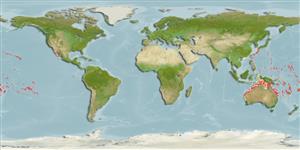Common names from other countries
>
Holocentriformes (Squirrelfishes, soldierfishes) >
Holocentridae (Squirrelfishes, soldierfishes) > Holocentrinae
Etymology: Sargocentron: Greek, sargos = sargus + Greek, kentron = sting (Ref. 45335).
Environment: milieu / climate zone / depth range / distribution range
Ökologie
seewasser riff-verbunden; tiefenbereich 10 - 45 m (Ref. 30874). Tropical
Indo-Pacific: Christmas Island in the eastern Indian Ocean to Australia eastward to Fiji and Samoa. Recently recorded from the Chesterfield Islands (Ref. 11897).
Size / Gewicht / Alter
Maturity: Lm ? range ? - ? cm
Max length : 20.0 cm TL Männchen/unbestimmt; (Ref. 90102)
Rückenflossenstacheln (insgesamt) : 11; Rückenflossenweichstrahlen (insgesamt) : 12 - 14; Afterflossenstacheln: 4; Afterflossenweichstrahlen: 8 - 9. Body light red to orange-red with narrow darker red stripes separating scale rows; white streak on head absent (except beneath maxilla); 4-5 oblique scale rows on cheek; body depth 2.65-2.95 in SL; head length (HL) 2.55-2.8 in SL; snout length 3.8-4.15 in HL; interorbital width 5.25-6.35 in HL; dorsal head profile slightly convex; maxilla extending to between verticals at front edge of iris and center of eye; upper jaw length 2.35-2.6 in HL; rounded anterior end of nasal bone; medial margin of nasal bone without retrorse spine; moderately large nasal fossa without spines; upper surface of nasal bone between nasal fossa and premaxillary groove edge with a retrorse spine; 2 opercular spines, with the lower 1/2-3/4 length of the upper; preopercular spine 4.8-6.35 HL; spinules on posterior margin of preopercle 17 (3.3 cm SL specimen), 19 (4.9 cm), 26 (5.3 cm), 30-36 (6.4-8.1 cm); 4th to 6th dorsal spines subequal, the longest, 2.3-2.65 in HL; 3rd anal spine 1.5-1.95 in HL; broadly rounded caudal-fin lobes (Ref. 27370).
Nocturnal. Minimum depth reported taken from Ref. 11897. Solitary and cryptic, found in outer reef slopes of oceanic islands, mainly in the South Pacific (Ref 90102).
Life cycle and mating behavior
Maturities | Fortpflanzung | Spawnings | Egg(s) | Fecundities | Larven
Randall, J.E., 1998. Revision of the Indo-Pacific squirrelfishes (Beryciformes: Holocentridae: Holocentrinae) of the genus Sargocentron, with descriptions of four new species. Indo-Pac. Fish. (27):105 p. (Ref. 27370)
IUCN Rote Liste Status (Ref. 130435)
CITES (Ref. 128078)
Not Evaluated
Bedrohung für Menschen
Harmless
Nutzung durch Menschen
Fischereien: nicht kommerziell
Tools
Zusatzinformationen
Download XML
Internet Quellen
Estimates based on models
Preferred temperature (Ref.
115969): 23.1 - 28.7, mean 27.2 (based on 154 cells).
Phylogenetic diversity index (Ref.
82804): PD
50 = 0.5000 [Uniqueness, from 0.5 = low to 2.0 = high].
Bayesian length-weight: a=0.01622 (0.00774 - 0.03400), b=2.97 (2.80 - 3.14), in cm Total Length, based on LWR estimates for this Genus-body shape (Ref.
93245).
Trophic level (Ref.
69278): 4.1 ±0.68 se; based on food items.
Widerstandsfähigkeit (Ref.
120179): hoch, Verdopplung der Population dauert weniger als 15 Monate. (Preliminary K or Fecundity.).
Fishing Vulnerability (Ref.
59153): Low vulnerability (10 of 100).
